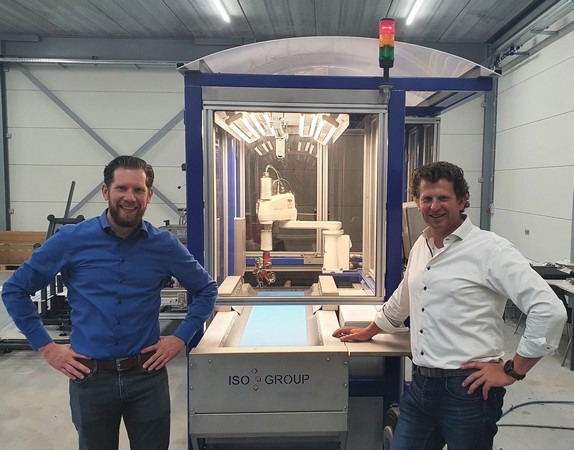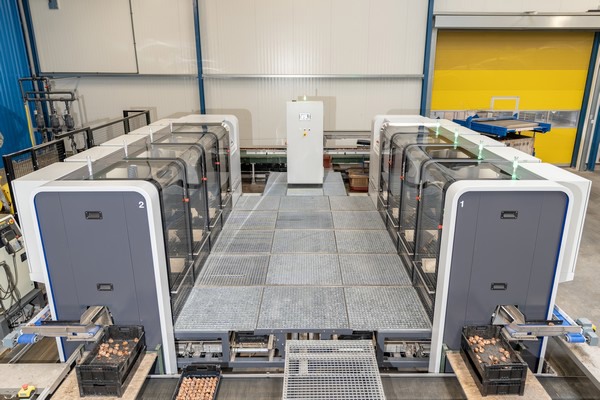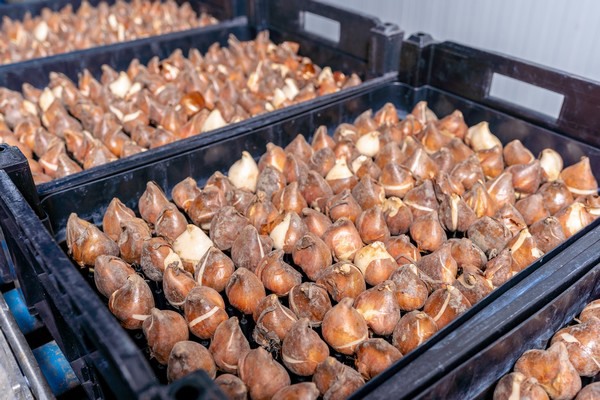Last year, ISO Group released their Bulb Planting System, which is able to plant up to 10,000 tulip bulbs per hour and identify non-healthy bulbs. This year, they will be installing 22 more machines in the Netherlands, meaning they are basically sold out for the 2021/2022 season, and there is already interest from other countries. Wim van der Meyden, Director, and Raymond van den Berg, International Sales Manager at ISO Group, share why the machine is so advantageous as well as the many challenges they had to face.
10,000 bulbs per hour
Van der Meyden and Van den Berg explain how the machine is able to automate the planting of 10,000 tulip bulbs per hour. “The bulbs go through the machine, after which it singulates the bulbs, because we want to take a look at each bulb individually. Then, six cameras scan the individual bulbs and take photos of it, of which a 3D model will be made. This provides us to take a good look at the orientation of the bulb as well as any possible diseases. If there is an ‘acid’ bulb we can recognize this and take it out of the remaining process. As a result, only the healthy tulip bulbs get planted."
"The Vision system calculates the coordinates of the bulb, and the machine puts it in the right position to put into the holder, a process that is fully based on Artificial Intelligence (AI). As the system works on AI, this means that we can constantly update and improve it. The more data we add to it, the better the machine will work. Especially when it comes to identifying the non-healthy bulbs, we have been able to increase the success rate. And once the crate is full the bulbs can go to the greenhouse.”
High demand
While the machine was only released last year, there has already proved to be a lot of demand for it. “Last year the machines have been operational a 3 growers with a total of 7 machines last year has been a great success. First off, the high demand is mostly because the availability of labor is very limited in the horticulture industry. Moreover, the workers that are available have often not received the proper training, which results in higher fail rates as the chances of not recognizing non-healthy bulbs become much higher. Usually, around 5-7% of tulip bulbs are ‘acid’, so our machine’s successful recognition is an important aspect.” At the moment, there are seven Bulb Planting Systems operational at three clients, and they are installing another 22 machines this year. For now, these machines are only operational in the Netherlands, as that is one of the major tulip-growing countries. “Yet we have noticed an interest from other countries, such as North America and England, so we are planning to take the machine to other countries in the near future.”

Challenges
Yet the development of the machine did not come without any challenges. “One of the biggest challenges while developing the machine was being able to do all of this without damaging the tulip bulb, which is quite an accomplishment as it is very fragile. Also, the tulip bulb is not a consistent product and each one’s shape and size is different, which compromises the reliability of singulating. Additionally, with some types of bulbs it is difficult to determine which side goes up, so determining the direction is another challenge. And all of these challenging aspects need to work at a relatively quick speed as well, as it plants up to 10,000 bulbs per hour. Therefore, the total development of the machine took us about three years, but we are excited about its results and the high demand.”
For more information
ISO Group![]()
Raymond van den Berg
[email protected]
https://www.iso-group.nl/en/
Paul Blom
[email protected]
